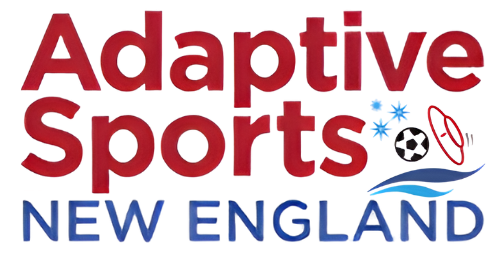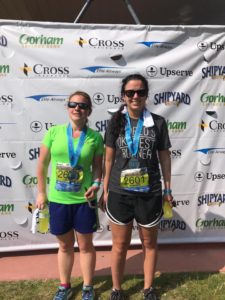By Jacob Albrecht and James Pandolfo
For thousands of runners around the world, running in the Boston Marathon is among the ultimate goals they set for themselves. For Lindsay Ball, this goal will become a reality on April, 15th in the 2019 Boston Marathon.
Ball, a visually impaired runner, will be a part of the Adaptive Sports New England Marathon Team. For Ball, this will be a massive goal accomplished that she’s been aiming toward since her high school days. However, she was not always a distance runner.
“I started running track in middle school,” said Ball. “I wasn’t very good because none of the coaches had any experience working with a visually impaired runner. I just did it to do it.”
It wasn’t until Ball met one of her best friends, Samara Garcia, that she entered into the world of distance running.
“My sophomore year of high school I met Samara and we became best friends,” said Ball. “She ran distance in indoor and outdoor track, and she told me one day to go to practice and run with her instead. She’s been stuck with me ever since.”
Samara will be guiding Lindsay in The Marathon, and Lindsay attributes a lot of her motivation and success to her friendship with Samara.
Samara is really good at holding me back and saying ‘Lindsay you’re not actually going to get any better unless you take some of these runs slower.’ She is the reason I ran my first marathon,” said Ball. “I really wanted to and I pushed her to do it with me last May when we ran Buffalo. She says to me she runs a lot because I run, we push each other and run for each other. She inspires me to run and do my best, and do it responsibly.”
Training for the Boston Marathon is a grueling process and one that Lindsay is a bit familiar thanks to her past experience in the Buffalo Marathon. She plans to follow a similar, albeit sped up, training method for Boston.
“Hal Higdon is a marathoner and he’s written a bunch of books. Last year when I ran the Buffalo Marathon I read one and used his beginner marathon training plan. I chose the beginner 2 plan this time,” said Ball. “It’s 18 weeks of running where you run 4 days a week, and then you can include some cross training into it. I’ve followed that, but we had to jump right into week 5 or 6. So it will be 12 weeks.”
However, when it comes to the Boston Marathon, it presents very different challenges than Buffalo. No marathon has the exact same route as another, and Boston varies greatly to Buffalo, especially in elevation. “I’m in upstate western New York and there’s no hills, no elevation change. That’s definitely going to be my weakness, sometimes when I run on the treadmill I change the elevation, but I have control over it so when I’m like ‘this stinks’ I put it back down..”
Regardless of the location of the race, all distance running requires an extensive amount of physical and mental strength and training. For a lot of runners, the mental aspect is much more impactful than the physical, and the same goes for Lindsay, “I’ve trained myself not to think about it. I did a 19 mile run on the treadmill a few weeks ago. I really just had to get there to the gym, get on the treadmill, turn it on, and not think about it. If I thought about the fact that I was running on a treadmill for 3 hours I probably would have cried. Since I’m in school, my school work is a distraction.”
That distraction has been essential to Ball’s preparation, even if it wasn’t always the easiest to work out, “I kept saying during midterms week that I wish that I had developed a way to do my homework and run for 3 hours at the same time and be extra multitasking, but I couldn’t figure that one out.”
For Lindsay, the challenges are amplified by the fact that she is a visually impaired runner. These challenges were most prevalent for Lindsay when she arrived at school in Brockport, NY.
“When I moved to Brockport to go to school I had been consistently running at home. Now I wasn’t really sure. I had to go to a new place and a new gym, and get to know everybody that worked there. Our treadmills aren’t accessible, they’re all touch screen and all the buttons are flat, so I can’t read the screen and I can’t turn it on. I can’t set my speed or monitor how far I’ve gone, so all of my coworkers have to monitor that for me. I was really nervous and anxious to have to go to the gym and ask for help.”
Lindsay was able to overcome these challenges due to her passion for running, “the need and desire to run and do something won over my nervousness,” said Ball. “I love it so much, and I can do it, so it motivates me and pushes me out of my comfort zone to make sure I do.”
The Boston Marathon is historic, scenic, and quite a chaotic experience. For those running, there’s a lot more than just finishing the race and their time that truly matter, “running Boston has been something that I’ve always wanted to do. My biggest goal is to do better than I did in the Buffalo Marathon. I just want to take everything in. Everybody talks so highly of the Boston Marathon, so just to be there and figure out what it’s all like.”
Despite the accomplishment of this lifelong goal, Lindsay’s long term goals stretch far beyond the Marathon, “I’m going to school for Adaptive Physical Education, I’m almost done with the undergrad portion of that. I student teach in the fall, and then I’m jumping right into my Master’s Degree for Adaptive PE. I want to teach, or work for a non-profit doing adaptive sport and hopefully specializing in blind and visually impaired,” said Ball.
Lindsay didn’t forget to include running in her plans for the future either, “I definitely want to keep running, I was really lucky that Adaptive Sports New England accepted me to run for charity which I was super excited about. I do someday want to qualify for Boston, it’s on my bucket list.”
As far as advice goes for athletes facing visual or physical impairments who are hesitant to get involved in sports, Lindsay has one major piece of advice.
“I would say that even though it may be out of their comfort zone and seem scary at the time, the benefits are going to outweigh that first nervousness or anxiety. If somebody is unsure of what sport or activity to do they should try a bunch of them and they’ll find their niche or what they really love. Just try it. I know it’s scary but the benefits are way better. What you get out of it way more than the anxiety or nervousness you’re going to have that holds you back.”




Comments are closed